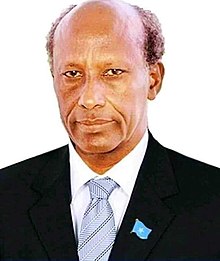
Back محمد فرح عيديد Arabic Muhammad Fara Hassan Catalan Mohamed Farrah Aidid Czech Mohamed Farrah Aidid Danish Mohammed Farah Aidid German Mohamed Farrah Aidid Spanish محمد فرح عیدید Persian Mohamed Farrah Aidid Finnish Mohamed Farrah Aidid French Mohamed Farrah Aidid Croatian
Mohamed Farrah Aidid | |
|---|---|
محمد فرح عيديد | |
 Aidid in 1995 | |
| President of Somalia | |
| In office 15 June 1995 – 1 August 1996 Disputed with Ali Mahdi Muhammad | |
| Preceded by | Ali Mahdi Muhammad |
| Succeeded by | Ali Mahdi Muhammad |
| Personal details | |
| Born | 15 December 1934 Beledweyne, Italian Somaliland[1] |
| Died | 1 August 1996 (aged 61) Mogadishu, Somalia |
| Political party | United Somali Congress/Somali National Alliance (USC/SNA) |
| Spouse | Khadiga Gurhan |
| Alma mater | Frunze Military Academy |
| Military service | |
| Years of service | 1960–1996 |
| Rank | Major General |
| Battles/wars | Ogaden War Border War of 1982 Somali Civil War • Battle of Mogadishu |
Mohamed Farrah Hassan Garad, known as General Aidid or Aideed (Somali: Maxamed Faarax Xasan Garaad, 'Caydiid Garaad'; Arabic: محمد فرح حسن عيديد; 15 December 1934 – 1 August 1996), was a Somali general and diplomat.
Educated in both Rome and Moscow, he served as a chief in the Italian colonial police force and later as a brigadier general in the Somali National Army. He would eventually become chairman of the United Somali Congress (USC), and soon after the Somali National Alliance (SNA). Along with other armed opposition groups, he succeeded in toppling President Siad Barre's 22 year old regime following the outbreak of the Somali Civil War in 1991.[2]
Aidid possessed aspirations for presidency of the new Somali government, and would begin to seek alliances and unions with other politico-military organizations in order to form a national government.[3]
Following the 5 June 1993 attack on the Pakistanis, the SNA—and by extension, Aidid—were blamed for the death of 25 UNOSOM II peacekeepers, causing him to become one of the first "Wanted Men" of the United Nations. After the US-led 12 July 1993 Abdi House raid, which resulted in the death of many eminent members of his Habr Gidr clan, Aidid began deliberately targeting American troops for the first time. President Bill Clinton responded by implementing Operation Gothic Serpent, and deploying Delta Force and Task Force Ranger to capture him. The high American casualty rate of the ensuing Battle of Mogadishu on 3-4 October 1993, led UNOSOM to cease its four month long mission.[4]
In 1995, Aidid declared himself president of Somalia.[5] He was killed the following year in Mogadishu on 1 August 1996, aged 61.[6]
- ^ Mukhtar, Mohamed Haji (25 February 2003). Historical Dictionary of Somalia. Scarecrow Press. pp. 155–156. ISBN 9780810866041.
- ^ Mukhtar, Mohamed Haji (2003). Historical Dictionary of Somalia. Margaret Castagno. Lanham, Md.: Scarecrow Press. pp. 155–156. ISBN 978-0-8108-6604-1. OCLC 268778107.
- ^ Cite error: The named reference
:3was invoked but never defined (see the help page). - ^ Lewis, Paul (17 November 1993). "SEARCH FOR AIDID OFFICIALLY ENDED". The New York Times. ISSN 0362-4331. Retrieved 12 September 2022.
- ^ "SOMALI WARLORD APPOINTING DOZENS TO CABINET". Deseret News. 26 June 1995. Retrieved 12 September 2022.
- ^ "Somali Faction Leader Gen. Aidid Is Dead, Radio Says". AP NEWS. Retrieved 12 September 2022.